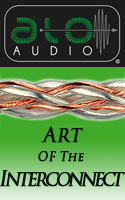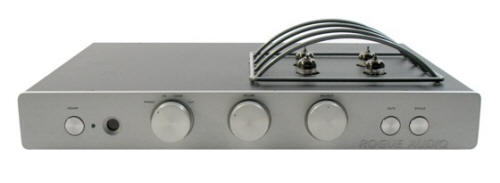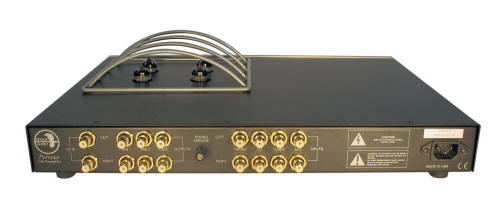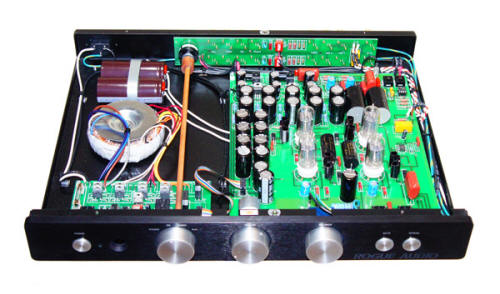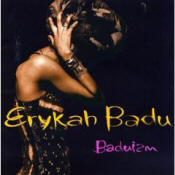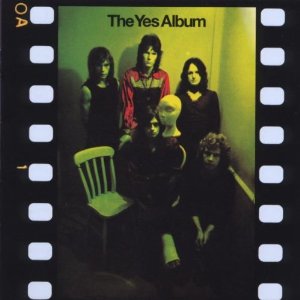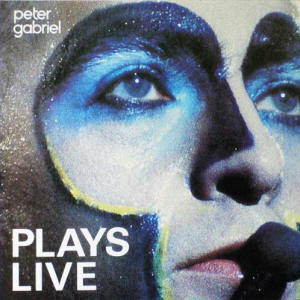|
|
You are reading the older HTML site
Positive Feedback ISSUE 61
rogue audio Perseus Magnum Preamplifier as reviewed by Steve Lefkowicz
Way back in 2003, or thereabouts, I decided to do a quick survey of moderately priced preamps or line-stages, looking mostly at tube designs, though not necessarily ruling out solid state devices. The idea was to find something to replace my (then) aging PS Audio 4H preamp. Well, I've never been known for rushing along with things, so now, almost ten years later, I'm submitting installment three of my survey. One thing about this, though, the short list of preamps under $2500 that I made several years ago shows many models are no longer manufactured, and others have increased in price quite a bit. I suppose it's time for a new list. Life is complicated sometimes… To clarify a few things up front, and before anyone get on my case for using a 28 year old solid-state preamp as my normal everyday reference, what can I say? There's something to be said for consistency. I use it in passive mode all the time; it imparts little character to the overall sound of the system, and has an excellent phono stage. As long as it's consistent, and I understand its limitations, I feel I have no issues with using it in the context of my "pretty good budget oriented audio system" it has served me well all these years. The Perseus Magnum preamp is the second Rogue Audio product I've reviewed. About six years ago I reviewed their Tempest II integrated amp, and found much to like about it (see PFO Issue 25). One thing I mentioned, and was actually very impressed by with that unit, was its ability to convey all the strengths one normally associates with tube electronics, without the usual vices that traditionally are part of the package. It had the harmonic richness, the ability to generate a wonderful, large, believable soundstage, the ease and liquidity in low frequencies, and a lack of dryness often associated with solid-state amps. However, it did not get flabby or loose in those low frequencies, did not roll off high frequencies, did not impart a background noise, or add any unnatural "warmth" to the sound. Apparently that is part of the Rogue audio sound; the benefits of tubes in a modern sounding package. The Perseus Magnum is a full function preamp in the modern sense of the term, in that it is an active line stage and has full MM/MC phono section included. It is still fairly minimalist in ease of use. There are three push buttons (power, mute, and bypass) and three knobs (source, volume, and balance) on the front panel. I really appreciate the balance control, and wonder why so many modern preamps leave this off. Four 12AU7 tubes peek out through the top plate, protected by a very stylish guard. There are internal adjustments that one can make for the phono section after removing the top plate. There are switches for gain (45dB for MM or 65dB for MC), capacitance (0pF or 150pF) and resistance (100, 300, 1000, and 47K ohms). To match up best with my Dynavector 19A, I set it for 65dB gain, 0 pF and 300 ohms. My PS Audio phono section starts to pick up a little noise when loaded below 1000 ohms, but the Rogue was totally silent at 300 ohm. More on that later.
The Perseus comes with a very nicely built and very minimalist remote. It is a very substantial piece, machined out of a solid chunk of aluminum. It has only two buttons; one for increasing volume, and as you would expect, the other for decreasing volume. I wish it had a mute button too. I also wish maybe it could generate smaller changes in volume. Though analog and continuous in use, even the quickest tap of one of the buttons often produced a little larger change that I wanted.
I had the good fortune of using the Perseus Magnum in my system with both my long time reference Direct Acoustics Silent Speakers, and also with my new favorite "$1000 or less" speakers, the Tekton Lore. The presentation of these two speakers is different enough that together they gave me a great deal of insight into the overall characteristics and sound of the preamp. How they reacted to the Perseus was consistent with the relative strengths of the two speaker systems. With the Perseus in my system and the Silent Speakers, I was most impressed with how the system opened up its soundstage. The Silent Speakers are capable of a huge, wall-to-wall stage presentation, but the size of the images in that stage can be pretty dependent on the quality of the preamp. I noticed that years ago when I had the Audio Space Line-2 in my system during my initial review the Silent Speakers. When running with my PS Audio preamp the stage was much smaller, and tended to stick more closely to the speakers themselves. The Perseus really opened up the stage and defined the size and location of the instruments better. Also, as powerful as the bass response of Silent Speakers can be, there was definitely an improvement in tonality and definition using the Perseus. Listening to Victor Wooten's bass work on various Bela Fleck and the Flecktones tracks was most impressive. On bass heavy tracks, like those of early Shaggy's Lucky Day or Erykah Badu's Baduism, the power was substantial, as expected, but with no bloat or loss of clarity.
Otherwise, as easy going and smooth as the Silent Speakers can generally be, and the way they have that ability to be a comfortable listen for long, all-day sessions, it was nice hearing an improvement in detail, overall clarity, and a more incisive sense of timing, without any negative tradeoff. Voices were more natural, as were most all instruments. I work out of my house, and too often I found myself forgetting to get back to work, or convincing myself that I had time for more tack, or even one more entire CD. Switching to the Tekton Lore speakers, driven at times by either the 15-watt Antique Sound Labs MG-15DT-S or a 60-watt Adcom GFA535, was also a case of the various strengths of the system being highlighted or improved upon. When using the Perseus, the already substantial dynamic capability of the system was opened up and made even more evident. The ability to surprise with an unrestrained crescendo was both exciting and notable. Well-recorded live recordings, such as Alan Holdsworth's Blues for Tony, where the live performance is superbly captured, just jump out with a sense and feel for the real event. In other words, the very things you want and expect from a well designed and executed tube preamp are there; finely detailed and textured soundstage, timbral accuracy and tonality, and greatly delineated dynamics, both large and small. What aren't there are the old school artifacts that many people still think of as part and parcel of "tube sound." There is no unnatural "warmth" to the sound, no midrange colorations that might sound pleasing even if inaccurate. The easy going sound isn't at the expense of detail or due to a softening or slowness in the initial attack of instruments' sound. The transient attack portrayed is as quick and decisive as any solid-state preamp I've heard. I think back to the Audio Space Line-2 that I reviewed in 2006. I may remember that line stage as generating a larger soundstage, or being a little more powerful in the bottom octave or two than the Perseus, but much has changed in my system and my life since then, most notably a new living space and much different sounding listening room. The differences I'm hearing may well be related to the change in rooms rather than in the two products. More importantly, I compare now the difference that the Audio Space is selling for $2390 (though listed in Stereophile's 2012 Buyer's Guide issue at $2790), has no remote, and no phono stage. That's not saying it is any less good than what I described in that issue 28 review, it's just that the Rogue, offers similarly good sound, a remote, a phono stage, and costs only $2195. That ramps up the good deal factor quite a bit for me. Speaking of the phono stage, I had a limited amount of time checking it out, mostly because most of my record collection is in storage. I had a few records handy to try it, but not the wide variety and quantity I would normally want to review a phono stage. As I mentioned earlier, I set the phono stage up for 300 ohms (using the internal switches) for the Dynavector 19A low output MC cartridge mounted on my Linn LP-12/Ittok front end. It shows how times have changed, that back when I bought my PS Audio 4H, preamps were judged principally on their phono stage and on their ability to play records. Line level inputs were for those secondary sources, unless you had a reel-to-reel feeding one of them. Now, it seems there is a lack of faith in built-in phono stages, and the expectations are lower, as if you would only use a built in phono stage until you bought a much more expensive stand alone phono preamp. I don't see it that way. There's no reason to expect a built in phono stage to be any less effective than a standalone unit, and it certainly eliminates the need and worry about what interconnect to use to hook the two up. Maybe it's just that I'm old enough to remember all preamps as having phono stages, so I am still comfortable with the idea. I was quite impressed with the phono stage of the Perseus. It was wonderfully quiet, even loaded down to 300 ohms (and when I tried it briefly at 100 ohms, too). The Perseus, at 300 ohms is dead silent as far as background noise goes. As I mentioned earlier, my PS Audio does pick up some low level noise when loaded down this low.
Musically, the phono section was quite good, and overall I could easily live with it, and view it as an improvement over what I use now. That is significant, as I've tried many budget phono preamps over the years, and though I've heard some nice units, I've never felt any were overall better than the phono stage of the PS Audio, which is primarily why I've kept it all these years. I was especially impressed by its clarity, and overall sense of timing. One of the records I had available was an early 70s issue of The Yes Album (by Yes, of course), and tracks like "Starship Trooper" and "Perpetual Change" were really well done. The Perseus had a great grip on the bass line (Chris Squire is one of my favorite bass players) in terms of speed and power. Jon Anderson's voice was clearly separated from the mix, and soared, yet with a sense of ease that belied how powerfully he can sing at times.
Peter Gabriel's Plays Live LP, one of the few live rock LPs I really like, simply rocked the house through the Perseus phono section. It's so much fun having low cost speakers that can still kick out serious bass, and I had to play this LP a couple of time through both sets of speakers (the Lore and the Silent Speaker) to hear how they each responded. Through both, the ability of the Perseus to present the overall power and dynamic content, especial in the low frequencies on tracks like "The Rhythm of the Heat", was thrilling. Yet, the subtle emotional content of "Solsbury Hill" was fully present, and not lost in the production. I wish I'd had my whole LP collection available during the review period, as I probably could have spent day after day listening to nothing but vinyl. I put listenability high on my list of attributes that are important. Since that isn't a real word, I'll define it as the ability that allows for enjoyable, long-term, non-fatiguing use. Though I only had about five LPs to use (one double LP set), I played them all several times and even after several hours I still felt like I could go on for several more. Not a lot of products I've heard over the years can really do that for me. The Perseus Magnum sits somewhat in the middle of Rogue's line of preamps. The line starts with the $1195 Metis (including a phono stage), and extends up to the $7995 Hera II (without a phono stage). I've heard these at various audio shows, and though that doesn't allow me to really comment on their specific sound quality, it does permit me to say that Rogue usually has truly fine sounding demo rooms at shows like CES. I can also say that it does appear that Rogue has a general house sound, which is overall as I've described in this review and in the old Tempest integrated amp review. In other words, they seem to get the best characteristics out of tube circuits without succumbing to the old tube artifacts and stereotypes. Modern, high tech, high quality sound is what I've consistently heard from their products, and the Perseus Magnum fits right in. This is a wonderful sounding preamp, and one that I can certainly recommend to anyone looking for a full-featured preamp with a phono stage. Steve Lefkowicz
Perseus Magnum Preamp
Rogue Audio
|

